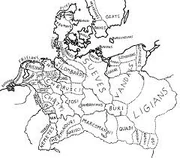The Cherusci were a Germanic tribe that inhabited parts of the plains and forests of northwestern Germania, in the area possibly near present-day Hanover, Germany, during the 1st century BC and 1st century AD. Ethnically, Pliny the Elder groups them with their neighbours the Suebi and Chatti, as well as the Hermunduri, as Hermiones, one of the Germanic groupings said to descend from an ancestor named Mannus. They led an important war against the Roman Empire. Subsequently they were probably absorbed into the tribal confederations such as the Franks and Allemanni.
In 9, in the Battle of the Teutoburg Forest, an army of allied Germanic tribes under the command of Arminius (the Cherusci, Bructeri, Marsi, Sicambri, Chauci and Chatti) annihilated three Roman Legions commanded by Publius Quinctilius Varus. The legions' eagle standards, of great symbolic importance to the Romans, were lost. The numbers of these three legions, Legio XVII, Legio XVIII, and Legio XIX, were never used again.

Location of the Chersuci in Germania.
After the mutinies of the German legions in 14, Germanicus decided, at the urging of his men, to march into Germany to restore their lost honor. In 15 AD, after a quick raid on the Chatti, invaded the lands of the Marsi. According to Tacitus (Annals 1, 51), an area 50 Roman miles wide was laid to waste with fire and sword: "No sex, no age found pity." A Legion eagle from Varus' defeat, either from the XVII or XVIII, was recovered. Then he began a campaign against the Cherusci. He then found the site of the Battle of Teutoburg Forest. His men buried the dead and built a funeral mound.
A series of battles followed. Inflicting minor casualties on the Romans, Arminius seemed to be gaining the upper hand, but in 16 Germanicus defeated Arminius at Idistaviso and in 18 at the Battle of the Angrivarian Walls. Following the decisive Roman victories, Arminius increasingly became embroiled in tribal disputes; his opponents accused him of trying to make himself king. In 21 Arminius "succumbed to treachery from his relations" (Tacitus) and a client king was appointed on the Germans by Rome.
Cherusci in Give Me Back My Legions![]
The Cherusci were one of a number of restless Germanic tribes that Publius Quinctilius Varus needed to pacify in order to bring the province more into the Roman Empire.
Some Cherusci, such as Segestes, were whole-heartedly in favor of becoming Roman. Arminius and his father Sigimerus were not. However, Arminius had learned how to hide his feelings and appear to be a proper Roman.
In 9 AD, Publius Varus was appointed the Roman military governor of Germany by the Emperor Augustus. The inexperienced Varus, who trusted Arminius, was advised to go through the Teutoburg Forest. Before he started, Varus also granted Arminius to "go to attend to his wife's pregnancy".
In fact, Arminius was actually bringing together all the Germanic tribes together to rise up against the Roman Empire. He then ordered his German warriors to build a disguised turf rampart both as a fortification and to conceal his forces. When the Legions began marching past, he restrained his warriors until the vanguard had gone by. Then he ordered several cast of spears as the main body began to pass.
Thousands of spears flew, cutting down many Romans. At this location, the path had narrowed between the forest and a swamp preventing the Romans from deploying. The Germans then attacked with swords and thrusting spears cutting down individual fighters who could not form to support each other. The ranks broke, some trying to escape through the swamp others back the way they had come but were blocked by their own rear who were thrown into confusion. The Germans fell on them all and only a few survived resulting in one of the largest Roman defeats ever.
Later, the Cherusci sent the preserved head of Varus to the leader of another Germanic tribe called Marcomanni to persuade them to join the uprising against the Romans. The Marcomannic leader refused and sent the head to Augustus.
| ||||||||||
